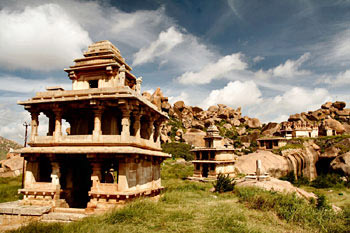Artistically sited amid Hospet and Bangalore, in the heart of the dusty central Karnatakan plateau, a series of granite hills rises surprisingly out of the plain. The rounded hills, which are liberally scattered with huge boulders, are reminiscent of the rocky landscape of Hampi, and also house a fortress of impressive strength. The city is Chitradurga, a magnificent small little town.
Archaeologists uncovered that the area has been important since early times, but the region really came into its own under a feudatory dynasty of Vijayanagar called the Chitradurga Nayakas. When Hampi or Vijayanagaram the, `city of victory` was sacked in 1565, these local chieftains became independent and the fortress became their main stronghold.
In 1779 the fort fell into the hands of Hyder Ali who, along with his son Tipu Sultan, strengthened and expanded it to the present shape that we see today. After Tipu`s defeat` by the British, the fort`s usefulness as a defensive structure ended.
Today the small town which grew up in the shadow of the fort has spread outside its old walled confines. Chitradurga is a pleasant little market town with a relaxed atmosphere. The massive granite walls blend seamlessly into the landscape around them, and this deceptive appearance makes Chitradurga all the more fascinating to explore.
Fort of Chitradurga
 Approximately 500 m south of the bus stand is the gateway to the old, walled town. A lane climbs gently for a further 500 m to the east gate of the fort.The entrance to the fort lies over the old moat and through the first gate, a massive construction of precisely cut granite blocks. With the exception of a couple of simple motifs on the walls, there is little ornamentation - the emphasis here is on sheer strength of defense. The indestructible walls are complimented by a winding entrance way which made the main gate more difficult for attackers to penetrate.
Approximately 500 m south of the bus stand is the gateway to the old, walled town. A lane climbs gently for a further 500 m to the east gate of the fort.The entrance to the fort lies over the old moat and through the first gate, a massive construction of precisely cut granite blocks. With the exception of a couple of simple motifs on the walls, there is little ornamentation - the emphasis here is on sheer strength of defense. The indestructible walls are complimented by a winding entrance way which made the main gate more difficult for attackers to penetrate.
Excatly to the left side of the first gate is the Banashankari temple and the grinding stones. The temple is in a tiny cave, which has been enlarged to house the statues of two deities. The images have been defaced but the temple is still in use and is tended by a priest. Twenty meters beyond the temple is a large stone-walled pit with four massive grinding stones arranged on the four sides. The stones, which were used in the manufacture of gunpowder, were turned by buffalo power. The central area around which the buffalo would have trudged is clear, but the elaborate cog system which must have turned the stones is now gone. Returning to the main path inside die front gate, follow the paved way up through four more gates - each as strong as the first - until it arrives at the inner area of the fort, on a saddle between die rocky hilltops. Continuing to climb, one passes through a further gate into the old palace area, which contains a number of buildings that are still in good shape. Notable among these is an impressive temple built on the rocky promontory overlooking the gates.
The highest point of the buildings in the fort are reached slightly further up the hill, and the main one is constructed against the rock face. Behind the building, a series of shallow footholds have been cut in the steep rock. These can be followed upto die central bastion, which is perched on the pinnacle above. From here there are excellent views of the whole fort. Circular parapets crown each of die surrounding hilltops. The fort is indeed a solid reminder of defense systems required in the medieval times.



















